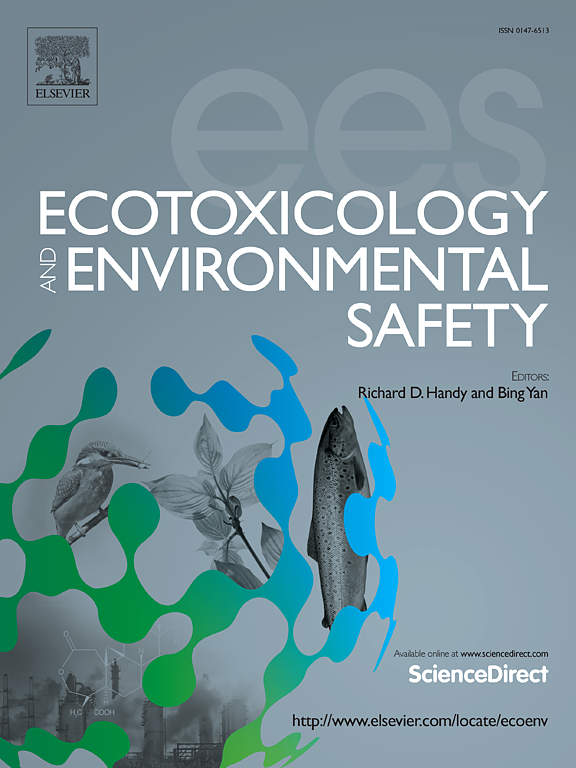Exposure to triphenyl phosphate during pregnancy: The role of gut-bile acids-liver axis on lipid metabolism in male offspring
IF 6.2
2区 环境科学与生态学
Q1 ENVIRONMENTAL SCIENCES
引用次数: 0
Abstract
The widespread use of Triphenyl phosphate (TPhP) as a substitute flame retardant in various commercial products has raised global concerns for its health risks. Previously, we found that gestational and lactational TPhP exposure disturbed lipid metabolism and gut microbiota in offspring sex-dependently. In this study, we further explored the prenatal TPhP exposure on lipid metabolism in male offspring, and the role of gut-bile acids-liver axis in it. The results showed that gestational TPhP exposure would induce hyperlipidemia in male offspring, it dose-dependently increased the weight of body and liver, levels of serum lipid, and enlarged lipid droplets in white adipose tissue. The expression of lipid metabolism-related genes was significantly changed in the liver and adipose tissue. The gut microbiome of male offspring was also altered, with different profiles between the low and high dose treatment group. Target bile acids (BAs) metabolites analysis revealed a significant increased levels of primary BAs cholic acid (CA), but decreased levels of chenodeoxycholic acid (CDCA), and decreased levels of the secondary BAs deoxycholic acid (DCA), hyodeoxycholic acid (HDCA), ursodeoxycholic acid (UDCA), and lithocholic acid (LCA) in TPhP treatment group. Measurements of gene expression along the gut-BAs-liver axis showed that the TPhP treatment group had an increase in cholesterol-7alpha-hydroxylase (CYP7A1) and a decrease in apical sodium-dependent bile acid transporter (ASBT), with only the low-dose group exhibiting an increase in carbohydrate response element binding protein (ChREBP). Correlation and mediation analysis highlighted associations of Burkholderiaceae in low-dose treatment group and Erysipelotrichaceae in high dose group with lipid metabolism and BAs metabolites. No consistent correlations were observed in two treatment group. Additionally, Mantel tests did not reveal a consistent correlation between the microbiome network community and lipid metabolism or the gut-bile acids-liver axis. Overall, our findings indicate that gestational TPhP exposure induces hyperlipidemia in male offspring, and while the gut-BAs-liver axis plays a role, other mechanisms warrant further investigation.
妊娠期暴露于磷酸三苯酯:肠胆汁酸-肝轴对雄性后代脂质代谢的作用。
磷酸三苯酯(TPhP)作为替代阻燃剂在各种商业产品中的广泛使用引起了全球对其健康风险的关注。先前,我们发现妊娠期和哺乳期TPhP暴露会干扰后代的脂质代谢和肠道微生物群,这与性别有关。在本研究中,我们进一步探讨了产前TPhP暴露对雄性后代脂质代谢的影响,以及肠胆汁酸-肝轴在其中的作用。结果表明,妊娠期暴露TPhP可诱导雄性子代高脂血症,其剂量依赖性地增加体重、肝脏重、血脂水平,并使白色脂肪组织脂滴增大。肝脏和脂肪组织中脂质代谢相关基因的表达明显改变。雄性后代的肠道微生物群也发生了变化,在低剂量和高剂量治疗组之间具有不同的特征。靶胆汁酸(BAs)代谢物分析显示,TPhP治疗组原发性胆汁酸(CA)水平显著升高,鹅去氧胆酸(CDCA)水平显著降低,次生胆汁酸(DCA)、羟基去氧胆酸(HDCA)、熊去氧胆酸(UDCA)和石胆酸(LCA)水平显著降低。沿着肠- bas -肝轴的基因表达测量显示,TPhP治疗组胆固醇-7 α -羟化酶(CYP7A1)增加,根尖钠依赖性胆酸转运蛋白(ASBT)减少,只有低剂量组碳水化合物反应元件结合蛋白(ChREBP)增加。相关分析和中介分析显示,低剂量组和高剂量组丹毒科与脂质代谢和BAs代谢物存在相关性。两组间无一致相关性。此外,Mantel试验并未揭示微生物组网络群落与脂质代谢或肠-胆汁酸-肝轴之间的一致相关性。总体而言,我们的研究结果表明,妊娠期TPhP暴露可诱导雄性后代高脂血症,虽然肠-基底-肝轴起作用,但其他机制有待进一步研究。
本文章由计算机程序翻译,如有差异,请以英文原文为准。
求助全文
约1分钟内获得全文
求助全文
来源期刊
CiteScore
12.10
自引率
5.90%
发文量
1234
审稿时长
88 days
期刊介绍:
Ecotoxicology and Environmental Safety is a multi-disciplinary journal that focuses on understanding the exposure and effects of environmental contamination on organisms including human health. The scope of the journal covers three main themes. The topics within these themes, indicated below, include (but are not limited to) the following: Ecotoxicology、Environmental Chemistry、Environmental Safety etc.

 求助内容:
求助内容: 应助结果提醒方式:
应助结果提醒方式:


